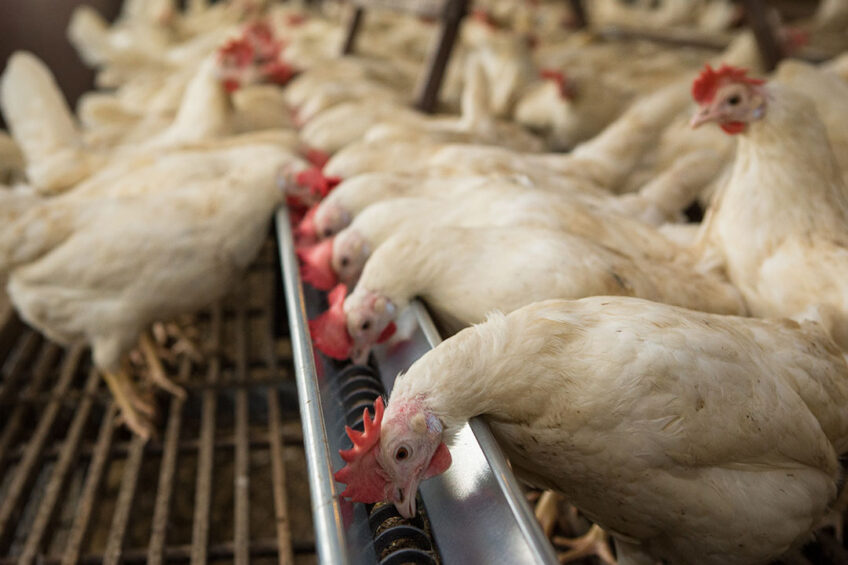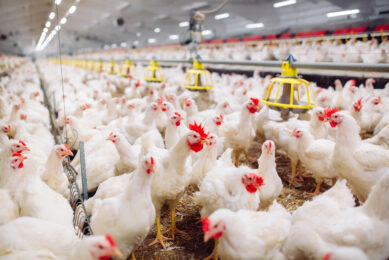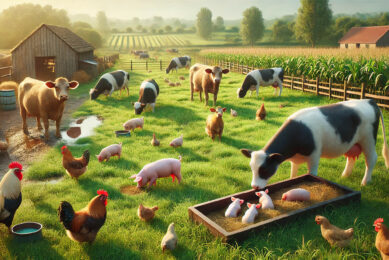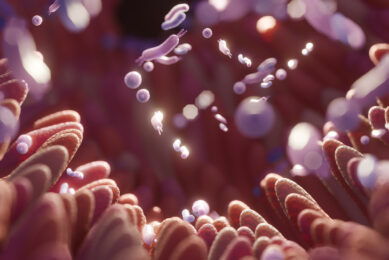Gut health in poultry: A holistic approach

A holistic approach to gut health looks at the whole picture, not just focusing on enteric diseases, but working on all contributing factors and considering the complex interactions between different parts: feed, microbiota and host immunity.
The impressive genetic improvement of broiler growth rates has enabled the poultry industry to meet with a worldwide increased demand for poultry meat. Compared to broiler production in the 1950-1960’s, birds today grow twice as fast. This improvement in growth and the corresponding feed conversion ratios has put enormous pressure on the digestive system of the birds. Therefore, it is essential to create a healthy intestine from the very beginning and to maintain optimal gut functions throughout the whole growth period to avoid enteric diseases, like necrotic enteritis (NE) and bacterial enteritis (BE) or dysbacteriosis. Any factor that compromises the integrity of the intestinal mucosa and its bacterial community will lead to decreased nutrient absorption. Additionally, activation of the immune system and repair processes will cost valuable nutrients and energy. Considering all of the above, the financial success of the poultry business is directly dependent on intestinal health.

Because of the risk of antimicrobial resistance connected with consumer concern for animal welfare and food safety, recent pressure on the usage of antimicrobials has caused intensive investigations to find alternative solutions to develop a healthy digestive system in animals without extensive use of antibiotics. Management changes and different alternatives for antibiotics such as probiotics, prebiotics, phytogenic products, organic acids and enzymes have been investigated to improve intestinal health and general animal performance.
Microbiota interaction
In the past, the investigation of intestinal bacterial population has been done with in vitro culture techniques. These techniques are able to assess only those bacterial species that can be grown in different media in laboratory conditions. Recently, modern approaches using molecular techniques were able to show that a significant part of intestinal microbiota has never been cultured. So actually only a small fraction of intestinal bacterial population has ever been studied so far. Any conclusions regarding the composition of intestinal microbiota and its functions must be drawn very carefully. Use of modern molecular techniques has led to a better understanding of the role of microbiota in oral tolerance and physiological functions of a healthy gut and has helped a lot to disqualify simplistic views such as the existing of ‘good’ Lactobacillus spp. and ‘bad’ Clostridium spp. bacteria.
Nowadays, microbiota is considered as a gene tool box that is complementing the gene pool of the host. The research is focusing on unravelling the complex interactions of what kind of gene pool is linked with good gut health and understanding how genes, both from the gut and its microbiota, can be switched on and off with different diet types, in order to reach the best performance, lowest level of inflammation, best digestive and absorptive properties. What we know so far, is that a composition of intestinal microbiota is changing throughout the life cycle of an individual, becoming quantitatively and qualitatively more complex with the age. Also environmental factors, such as stocking density, diet composition and feeding practice, management, housing conditions, pathogen load in the environment, use of antibiotics can modify intestinal microbiota. Feed withdrawal, especially over longer time, causes reduction in the number of detected bacterial species. Also from one segment of the gastro-intestinal tract to the other, bacterial populations of the gut vary significantly. In the small intestine of a healthy bird, Lactobacillaceae spp. are dominant, where as in caeca Clostrideaceae spp. are prevailing, which is connected with different pH and physiologic functions of these intestinal segments.
There are some members of the mucosa-associated microbial community that are considered to be especially crucial for a healthy status of the gut. These are bacteria producing short chain fatty acids, like acetic, propionic and butyric acid, during the fermentation process of dietary carbohydrates. Production of butyrate near the epithelial cells and in close association with invading and histotoxic pathogens promotes development and recovery of the villi, stimulates the expression of the tight junction proteins, limits invasion of pathogens such as E. coli and Salmonella and further promotes a beneficial microbial ecosystem, which leads to an overall increased tissue health. On the contrary, mucin-desulphating bacteria and sulphate reducers create hydrogen sulphide, which enhances some pathogens and causes tissue damage, see Figure 1.
Figure 1 – Macroscopic dysbacteriosis scoresystem parameters.
- A. Overall gut ballooning;
- B. Content of the intestinal tract, 1. Mucoid, orange intestinal content, 2. Foamy intestinal content;
- C. Tonus of the intestinal tract, 1. Good tonus, 2. Lack of tonus;
- D. Macroscopically visible thickness of the intestinal tract, 1. Macroscopically thin intestinal tract, 2. Intestinal tract with normal
- thickness;
- E. Undigested particles in the colon (arrows); F. Inflammation of the gut, 1. Inflammation, 2. No inflammation.

(Source: De Gussem, 2010).
Vicious circle of bacterial enteritis
Since the ban of antimicrobial growth promoters in Europe in 2006, digestive problems such as BE or dysbacteriosis and even necrotic enteritis, have increased. The aetiology of BE is multifactorial, in modern broiler breeds, selected for maximal growth rate and high feed intake, abundance of non-absorbed nutrients in the gut lumen, in absence of growth promoters with antibacterial properties, causes a chain of events that exacerbates the proliferation of some clusters of bacteria that leads to an inflammatory reaction of the gut wall. This reaction of the gut wall in its turn instigates microscopic and macroscopic changes that, as in a vicious circle, will lead to poorer physiologic status of the intestine and to poor digestive and absorptive functions, resulting in even more nutrients in the intestinal lumen, and more substrate for bacterial growth.
Figure 2 – Bacterial enteritis vicious circle (De Gussem, 2010).

The pathogenesis of BE can be described as a vicious circle in 4 steps, see Figure 2 .
- In the first step, the shift of the healthy gut towards BE starts with oversupply of nutrients in the intestinal lumen. In today’s broilers, the very high feed intake has accelerated the general feed passage rate in the intestine. So, even minor violations of the digestion and absorption will lead to an increase in the number of nutrients, especially of undigested proteins and high-energy nutrient particles in the hind gut. Among gut damaging factors of infectious origin, coccidiosis is considered to be the most important, but also virus infections can destroy intestinal epithelia, shorten intestinal villi and lead to poor absorption of the intestine. The stressors of non-infectious origin are dietary changes, nutritional imbalance, soluble non-starch polysaccharides (NSP), enzymatic dysfunctions, mycotoxins and management issues.
- As a consequence of the oversupply of nutrients in the intestinal lumen, a shift in proliferation of some clusters of bacteria occurs in the small intestine in step 2 of the vicious circle. The presence of excessive nutritional factors mainly favours the proliferation of Clostridium perfringens and Lactobacilli and disfavours certain Clostridiaceae.
- In step 3, this disruption of a very fine balance in gut microbial constellation may shift intestinal immune tolerance towards pathological inflammation reactions and oxidative stress in the gut wall, so morphological and functional alterations in the intestine occur. In case of overgrowth of Clostridium perfringens spp. producing Netβ toxin, these alterations even results in necrotic enteritis, as Netβ toxin directly destroys the intestinal lining.
- Step 4 of the vicious circle of BE is characterised by poor digestion of feed and poor absorption of nutrients, as the damaged intestine is not able to fulfil its functions. The above described 4 steps of the vicious circle, result in a less functioning gut, which in turn leads to further oversupply of nutrients in the intestinal lumen, further reinforcing the vicious circle of BE.
Strategic use of additives and medication
The choice of best (so called traditional and alternative) solutions should be tailor made for each operation, looking at the 4 steps of the vicious circle and what contributing factors are causing damage to intestinal health. Solutions work on different parts of the cycle. Some products have antagonistic, some additive and some have a synergistic effect. Some products will go through the drinking water, some will go through feed or can be sprayed on the chicks or even in the environment. Examples of traditional additives are antimicrobial growth promoters, anticoccidials, feed enzymes, antibiotics, coccidiosis vaccines, acids used as feed preservative, mycotoxin binders. Examples of alternatives are acids used to steer gut microbiota, probiotics, etheric oils, bacteriophages, beta-glucans. In fact the differentiation is very artificial, as some products can be part of either category, and the ones that are alternative now will be standard in a few years’ time. Therefore I opt not to discriminate and just categorise all of them as gut health support tools.
It all starts with understanding
The objective is to define what tools are relevant in terms of efficacy and cost for your operation. It all starts with understanding where your BE cycle is fuelled from. Usually it will be a complex combination of challenges, but with a good starting diagnosis of your flocks you will understand where the low hanging fruit is. Coccidiosis for instance is very often the primary instigator of the BE cycle. The levels at your farm can be very different from neighbouring farms and understanding this can help you to define if you need to invest more in coccidiosis control or maybe if you can save some money that can be used to fight other challenges such as mycotoxins, microbiota shifts, inflammation at level of gut or dealing with litter quality issues. On the other hand, if your coccidiosis levels are higher than average, it is very unlikely that the best return on investment will yield from adding a probiotic in drinking water. Changing the anticoccidial programme will for sure give you the best results as coccidiosis will have a direct impact on performance, but also reducing coccidiosis levels will give less fuel to your BE cycle.
Impact of gut health tools on performance
So it all starts with making a good diagnosis of what is going on by using scoring methods to define the levels of gut health challenge. Next, will be listing all what is being done already to support gut health and estimate a cost per kg bird produced. This data can then be analysed to understand where breaking the BE cycle can be most successful and where it is unlikely to be broken, and importantly at what cost. Choosing gut health support tools then becomes an easier task, with usually a huge impact on performance and ease of growing birds and very importantly with lower cost of gut health support tools but also lower FCR and higher ADG.
In poultry production, intestinal health is capital for performance. Since the ban of antimicrobial growth promoters over 10 years ago in the EU, research has shown the importance of general health on the intestinal microbial community and the complex interaction with the host. Intestinal health can be improved feed composition, medication and additives to maintain a rich and diverse microbial community, and to control the host reaction through dietary immunomodulation.
Join 13,000+ subscribers
Subscribe to our newsletter to stay updated about all the need-to-know content in the dairy sector, two times a week.










